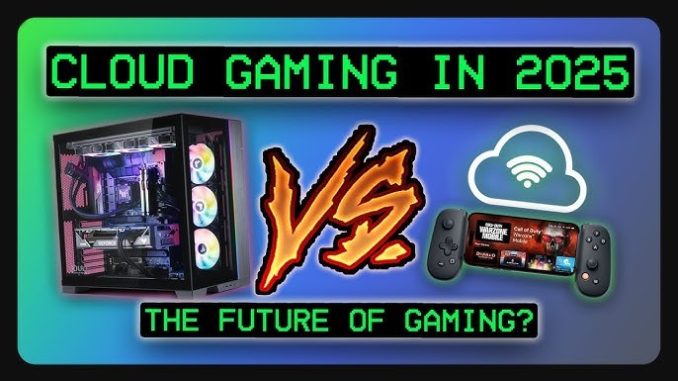
The global video game industry, a colossal entertainment powerhouse, has consistently pushed the boundaries of technology, from pixelated sprites to hyper-realistic virtual worlds. However, perhaps no innovation since the internet itself holds as much transformative potential as cloud gaming. This revolutionary approach is fundamentally altering how games are developed, distributed, and consumed, dismantling long-standing barriers and ushering in an era of unprecedented accessibility and flexibility.
At its core, cloud gaming, often referred to as “game streaming” or “gaming-as-a-service,” shifts the heavy computational burden of running a video game from the user’s local device to powerful remote servers in data centers. When a player initiates a game, the servers handle all the intensive processing—rendering graphics, managing game logic, and computing physics. The resultant video and audio feed is then streamed back to the player’s device, while their inputs (controller presses, mouse movements) are sent back to the server in real-time. This dynamic interplay means that a high-fidelity, graphically demanding game can be played on virtually any internet-connected screen, be it a smartphone, tablet, smart TV, or a low-spec laptop.
One of the most profound impacts of cloud gaming is the **democratization of access to high-end gaming experiences**. Historically, enjoying the latest “AAA” titles required significant upfront investment in expensive hardware, whether a cutting-edge gaming PC or a powerful console. This created a barrier to entry for many potential players, particularly in regions where economic disparities limit access to such devices. Cloud gaming shatters this barrier, as the cost of hardware is essentially offloaded to the service provider. For a subscription fee, akin to video streaming services like Netflix, users gain access to a vast library of games, transforming a potential €500-€1000 hardware investment into an affordable monthly expense. This expansion of the potential player base opens up entirely new markets for game developers, reaching audiences previously untapped. For example, a student in Berlin with only a basic tablet can now play the latest visually stunning action game without needing a high-end gaming PC.
For game developers and publishers, cloud gaming offers several compelling advantages that are reshaping their business models and development processes. Firstly, it **transcends hardware limitations**, liberating developers from the need to constantly optimize games for a myriad of device specifications. Instead, they can focus on building ambitious, graphically rich games that leverage the immense power of cloud servers, rather than being constrained by the processing power of an end-user’s device. This can lead to more immersive worlds, more complex simulations, and more realistic AI, pushing the boundaries of what’s possible in game design.
Secondly, cloud gaming significantly **simplifies game distribution and updates**. With games running on remote servers, players no longer need to endure lengthy downloads, installations, or massive patch updates. Games are available instantly, and developers can push updates and new content seamlessly to the server, ensuring all players are always on the latest version without any hassle. This streamlined process reduces friction for players and allows developers to iterate faster, fix bugs more quickly, and introduce new features more fluidly. This translates to a smoother, uninterrupted gaming experience for the consumer and more agile development cycles for the creators.
Furthermore, cloud gaming fosters **cross-platform compatibility and enhanced multiplayer experiences**. Since the game logic and rendering occur in the cloud, it’s inherently easier to deliver a consistent gaming experience across diverse devices and operating systems. This means players can seamlessly switch between their smartphone, tablet, and smart TV, picking up their game exactly where they left off. For multiplayer games, the centralized processing on cloud servers can lead to lower latency and more stable connections, creating a smoother and more equitable competitive environment, as network performance relies less on individual player’s local machines.
However, the transformative potential of cloud gaming comes with its own set of challenges that the industry is actively addressing. **Internet connectivity and latency** remain critical factors. A fast, stable internet connection is paramount for a smooth cloud gaming experience; any significant lag between player input and on-screen response can severely degrade gameplay, especially for fast-paced genres like first-person shooters. While advancements in 5G networks and edge computing (placing servers closer to end-users) are mitigating these issues, robust internet infrastructure is not yet universally available. Data consumption is also a consideration, as streaming high-quality video for hours can consume significant bandwidth, a factor for users with data caps.
Moreover, the shift to a service-based model raises questions about **game ownership and content licensing**. In a subscription model, players typically do not “own” the games; they merely access a library. If a service discontinues a game or ceases operations, players could lose access to their purchased content, a concern that traditional physical or digital downloads do not fully present. Business models are still evolving, with some services offering a “Netflix-like” subscription, while others allow users to stream games they already own on other platforms.
Despite these hurdles, the trajectory of cloud gaming is undeniably upward. Market predictions for 2025 and beyond show substantial growth, with increasing internet penetration, especially in emerging markets, and continuous technological refinements driving adoption. As AI optimizes streaming quality, dynamically adjusting resolution and frame rates based on real-time network conditions, and as 5G networks become pervasive, cloud gaming is set to deliver increasingly seamless and immersive experiences. This shift not only democratizes access to gaming but also empowers developers to innovate without the traditional shackles of hardware limitations, solidifying cloud gaming’s position as a cornerstone of the video game industry’s exciting future.